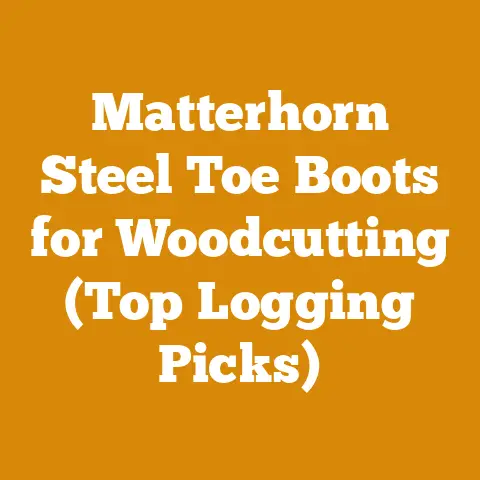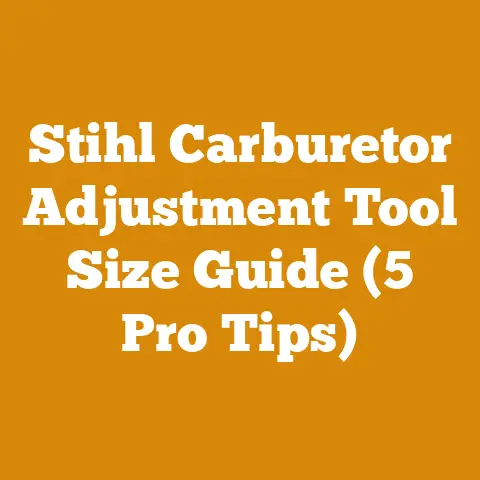Deep Root Feeding Trees (5 Pro Tips for Optimal Wood Growth)
Imagine your favorite oak tree, standing tall and proud, its leaves a vibrant green canopy against the sky.
Now imagine that same tree, weakened, its growth stunted, its leaves a pale shadow of their former glory.
What if I told you there’s a way to ensure your trees thrive, reaching their full potential and providing you with years of beauty and benefits?
That’s where deep root feeding comes in, and I’m here to share my pro tips for optimal wood growth.
Deep Root Feeding Trees: 5 Pro Tips for Optimal Wood Growth
Deep root feeding is a technique that delivers essential nutrients directly to a tree’s root zone, bypassing the surface soil which may be depleted or compacted.
It’s like giving your tree a targeted vitamin boost, ensuring it gets exactly what it needs to flourish.
I’ve seen firsthand the dramatic difference deep root feeding can make, transforming struggling trees into vibrant, healthy specimens.
Over the years, I’ve worked with countless trees, from saplings to mature giants, and I’ve learned a few tricks along the way.
Let’s dive into my top 5 pro tips to help you achieve optimal wood growth.
1. Understanding the “Why” of Deep Root Feeding
Before you grab your tools and start injecting fertilizer, it’s crucial to understand why deep root feeding is beneficial and whether your tree actually needs it.
Not all trees require this treatment, and misapplication can actually do more harm than good.
When is Deep Root Feeding Necessary?
- Poor Soil Conditions: Compacted soil, nutrient-deficient soil, or soil with an imbalanced pH can hinder root growth and nutrient uptake.
I remember working on a property where the soil was so compacted from construction that the trees were practically starving.
Deep root feeding was the only way to get nutrients to the roots. - Stressful Environments: Trees in urban areas, near roads, or exposed to pollution often experience stress that limits their ability to absorb nutrients.
Think of trees planted near sidewalks; the concrete can significantly alter the soil pH and prevent rainwater from reaching the roots. - Signs of Nutrient Deficiency: Yellowing leaves (chlorosis), stunted growth, dieback of branches, and sparse foliage are all telltale signs that your tree may be lacking essential nutrients.
I once diagnosed a severe iron deficiency in a maple tree simply by observing its pale, yellow leaves. - Post-Transplant Shock: Newly planted trees often struggle to establish their root systems.
Deep root feeding can provide a much-needed boost to help them overcome transplant shock.
I always recommend deep root feeding for newly planted trees, especially larger specimens. - Mature Trees: Even healthy mature trees can benefit from deep root feeding, especially in the fall, to help them build up reserves for the winter.
- Poor Soil Conditions: Compacted soil, nutrient-deficient soil, or soil with an imbalanced pH can hinder root growth and nutrient uptake.
When to Avoid Deep Root Feeding:
- Healthy Trees: If your tree is already thriving, with vibrant foliage and vigorous growth, there’s no need to deep root feed.
- Over-Fertilization: Excessive fertilization can lead to nutrient imbalances and even burn the roots.
- Disease or Pest Infestation: Deep root feeding won’t cure a disease or eliminate pests.
Address these issues first. - Waterlogged Soil: Deep root feeding in waterlogged soil can exacerbate root rot.
Soil Testing: The Foundation of Effective Feeding:
- Before you even think about deep root feeding, get your soil tested.
A soil test will reveal the pH level, nutrient deficiencies, and any other imbalances in your soil.
This information is crucial for determining the right type of fertilizer and the appropriate application rate.
I always tell people, “Don’t guess, test!” It’s the most accurate way to diagnose your tree’s needs. - You can purchase a soil testing kit online or from your local garden center.
Follow the instructions carefully to collect a representative sample of your soil.
Send the sample to a reputable laboratory for analysis. - Once you receive the results, consult with a certified arborist or horticulturalist to interpret the findings and develop a customized deep root feeding plan.
- Before you even think about deep root feeding, get your soil tested.
Takeaway: Understanding your tree’s specific needs and soil conditions is paramount before embarking on deep root feeding.
A soil test is your best friend.
2. Choosing the Right Fertilizer: A Nutrient Cocktail for Success
Selecting the appropriate fertilizer is just as important as understanding the “why” of deep root feeding.
Not all fertilizers are created equal, and using the wrong one can be detrimental to your tree’s health.
Understanding Fertilizer Labels:
- Fertilizers are labeled with three numbers, representing the percentage of nitrogen (N), phosphorus (P), and potassium (K) in the mixture.
These are the three macronutrients that trees need in the largest quantities.
For example, a 10-10-10 fertilizer contains 10% nitrogen, 10% phosphorus, and 10% potassium. - Nitrogen promotes leaf and stem growth, phosphorus supports root development and flowering, and potassium enhances overall plant health and disease resistance.
- Fertilizers are labeled with three numbers, representing the percentage of nitrogen (N), phosphorus (P), and potassium (K) in the mixture.
Types of Fertilizers for Deep Root Feeding:
- Slow-Release Fertilizers: These fertilizers release nutrients gradually over a period of several months, providing a steady supply of nourishment to the roots.
I prefer slow-release fertilizers for deep root feeding because they minimize the risk of burning the roots and provide long-lasting benefits. - Water-Soluble Fertilizers: These fertilizers dissolve quickly in water and are readily available to the roots.
They are ideal for addressing immediate nutrient deficiencies, but they need to be applied more frequently than slow-release fertilizers. - Organic Fertilizers: These fertilizers are derived from natural sources, such as compost, manure, and bone meal.
They release nutrients slowly and also improve soil health.
I often use organic fertilizers in combination with slow-release fertilizers for a balanced approach. - Specific Nutrient Deficiencies: If your soil test reveals a specific nutrient deficiency, such as iron or manganese, you may need to use a fertilizer that is specifically formulated to address that deficiency.
Iron chelate, for example, is a common treatment for iron chlorosis.
- Slow-Release Fertilizers: These fertilizers release nutrients gradually over a period of several months, providing a steady supply of nourishment to the roots.
Recommended Fertilizer Ratios:
- General Purpose: A balanced fertilizer, such as a 10-10-10 or 20-20-20, is suitable for most trees.
- Root Development: For newly planted trees or trees with poor root systems, a fertilizer with a higher phosphorus content, such as a 10-20-10, is recommended.
- Foliage Growth: For trees that need to boost leaf growth, a fertilizer with a higher nitrogen content, such as a 20-10-10, is recommended.
- Mature Trees: Mature trees generally require less nitrogen and more potassium.
A fertilizer with a lower nitrogen content and a higher potassium content, such as a 5-10-15, is a good choice.
My Personal Fertilizer Recipe:
- Based on my experience, I often use a combination of slow-release fertilizer (15-9-12) and organic compost tea.
The slow-release fertilizer provides a steady supply of macronutrients, while the compost tea adds beneficial microbes and micronutrients to the soil.
I’ve seen amazing results with this combination. - The amount of fertilizer you need will depend on the size of your tree and the severity of the nutrient deficiency.
Always follow the manufacturer’s instructions and consult with a certified arborist if you’re unsure.
- Based on my experience, I often use a combination of slow-release fertilizer (15-9-12) and organic compost tea.
Takeaway: Choosing the right fertilizer is crucial for successful deep root feeding.
Consider your tree’s specific needs, soil conditions, and the type of fertilizer that best suits your situation.
3. The Tools of the Trade: Equipping Yourself for Success
Having the right tools is essential for efficient and effective deep root feeding.
While the process itself is relatively simple, using the wrong equipment can make it difficult and even damage your tree.
Deep Root Feeding Injector:
- This is the primary tool for deep root feeding.
It consists of a long probe that is inserted into the soil and connected to a tank or hose that delivers the fertilizer solution. - There are two main types of deep root feeding injectors:
- Hand-Operated Injectors: These injectors are manually pumped and are suitable for small trees or for treating a small number of trees.
They are relatively inexpensive and easy to use. - Powered Injectors: These injectors are powered by a gas engine or an electric motor and are designed for treating larger trees or for commercial use.
They are more expensive than hand-operated injectors, but they are also more efficient and can cover a larger area in less time.
- Hand-Operated Injectors: These injectors are manually pumped and are suitable for small trees or for treating a small number of trees.
- When choosing a deep root feeding injector, consider the size of your trees, the number of trees you need to treat, and your budget.
I personally prefer powered injectors for larger projects, but hand-operated injectors are perfectly adequate for smaller jobs.
- This is the primary tool for deep root feeding.
Soil Auger or Drill:
- A soil auger or drill is used to create holes in the soil for the deep root feeding injector.
This is especially important in compacted soil, where it can be difficult to insert the injector probe. - A soil auger is a hand-operated tool that is used to drill holes in the soil.
It is relatively inexpensive and easy to use, but it can be tiring to use for larger projects. - A drill with a long auger bit can also be used to create holes in the soil.
This is a more efficient option for larger projects, but it requires a power source.
- A soil auger or drill is used to create holes in the soil for the deep root feeding injector.
Measuring Cups and Buckets:
- Accurate measurement is crucial for ensuring that you are applying the correct amount of fertilizer.
Use measuring cups and buckets to precisely measure the fertilizer and water.
- Accurate measurement is crucial for ensuring that you are applying the correct amount of fertilizer.
-
Water Hose:
- A water hose is needed to connect the deep root feeding injector to a water source.
-
Safety Gear:
- Always wear safety glasses and gloves when deep root feeding to protect yourself from the fertilizer solution.
My Go-To Tool Setup:
- For most of my deep root feeding projects, I use a powered injector with a 30-gallon tank.
This allows me to cover a large area without having to refill the tank frequently.
I also use a drill with a 12-inch auger bit to create holes in compacted soil.
And of course, I always wear safety glasses and gloves.
- For most of my deep root feeding projects, I use a powered injector with a 30-gallon tank.
Takeaway: Investing in the right tools will make deep root feeding easier, more efficient, and safer.
Choose tools that are appropriate for the size of your trees and the scope of your project.
4. The Art of Application: Techniques for Effective Deep Root Feeding
The technique you use for deep root feeding can significantly impact its effectiveness.
Proper application ensures that the fertilizer reaches the roots and is absorbed efficiently.
Determining the Root Zone:
- The root zone of a tree extends outwards from the trunk to the drip line, which is the outermost edge of the tree’s canopy.
Most of the tree’s feeder roots, which are responsible for absorbing water and nutrients, are located within this zone. - When deep root feeding, focus on the area within the drip line, avoiding the area immediately around the trunk.
- The root zone of a tree extends outwards from the trunk to the drip line, which is the outermost edge of the tree’s canopy.
Spacing and Depth of Injection Points:
- Space the injection points 2-3 feet apart within the root zone.
This ensures that the fertilizer is distributed evenly throughout the root system. - The depth of injection should be 8-12 inches.
This is the optimal depth for reaching the feeder roots. - I like to use a grid pattern for my injection points, ensuring that I cover the entire root zone.
- Space the injection points 2-3 feet apart within the root zone.
Injection Technique:
- Insert the injector probe into the soil at a slight angle, rather than straight down.
This helps to distribute the fertilizer more evenly. - Inject the fertilizer solution slowly and steadily, allowing it to soak into the soil.
Avoid injecting too much fertilizer at once, as this can lead to runoff and waste. - As you inject the fertilizer, move the probe up and down slightly to create a small pocket of fertilizer in the soil.
- After injecting the fertilizer, remove the probe and gently tamp down the soil to close the hole.
- Insert the injector probe into the soil at a slight angle, rather than straight down.
-
Application Rate:
- The amount of fertilizer you need to apply will depend on the size of your tree, the type of fertilizer you are using, and the severity of the nutrient deficiency.
- Always follow the manufacturer’s instructions and consult with a certified arborist if you’re unsure.
- As a general guideline, you can use the following formula to calculate the application rate:
- Tree Diameter (inches) x Fertilizer Rate (pounds per inch of diameter) = Total Amount of Fertilizer (pounds)
- For example, if you have a tree with a diameter of 10 inches and you are using a fertilizer with a rate of 0.5 pounds per inch of diameter, you would need to apply 5 pounds of fertilizer.
-
Watering After Application:
- After deep root feeding, water the tree thoroughly to help the fertilizer soak into the soil and reach the roots.
My Secret Weapon: Soil Amendments:
- In addition to fertilizer, I often add soil amendments to the deep root feeding solution.
These amendments can include compost tea, humic acid, and mycorrhizae. - Compost tea adds beneficial microbes to the soil, which help to improve nutrient uptake.
Humic acid helps to chelate nutrients, making them more available to the roots.
Mycorrhizae are beneficial fungi that form a symbiotic relationship with the roots, helping them to absorb water and nutrients more efficiently.
- In addition to fertilizer, I often add soil amendments to the deep root feeding solution.
Takeaway: Proper application is key to maximizing the benefits of deep root feeding.
Pay attention to the root zone, spacing and depth of injection points, injection technique, and application rate.
5. Timing is Everything: When to Deep Root Feed for Optimal Results
The timing of deep root feeding can significantly impact its effectiveness.
Feeding at the wrong time can be a waste of time and money, and it can even harm your tree.
Optimal Times for Deep Root Feeding:
- Early Spring (Before Bud Break): This is the ideal time to deep root feed because the tree is just beginning to emerge from dormancy and is actively seeking nutrients to support new growth.
I like to think of it as giving the tree a “wake-up call” after the long winter. - Fall (After Leaf Drop): This is another excellent time to deep root feed because the tree is storing up energy for the winter.
Deep root feeding in the fall helps the tree to build up its reserves and prepare for the stresses of winter.
I consider it a “winterizing” treatment. - Avoid Deep Root Feeding During the Summer: The heat of the summer can stress trees, and deep root feeding during this time can exacerbate the stress.
Also, the tree is actively growing during the summer, so it may not be able to absorb the nutrients as efficiently.
- Early Spring (Before Bud Break): This is the ideal time to deep root feed because the tree is just beginning to emerge from dormancy and is actively seeking nutrients to support new growth.
Considerations for Specific Tree Species:
- Some tree species have specific nutrient requirements and may benefit from deep root feeding at different times of the year.
For example, evergreens may benefit from a late-fall feeding to help them retain their color throughout the winter. - Consult with a certified arborist to determine the best time to deep root feed your specific tree species.
- Some tree species have specific nutrient requirements and may benefit from deep root feeding at different times of the year.
Weather Conditions:
- Avoid deep root feeding during periods of heavy rain or drought.
Heavy rain can wash away the fertilizer, while drought can make it difficult for the tree to absorb the nutrients. - The ideal time to deep root feed is when the soil is moist but not saturated.
- Avoid deep root feeding during periods of heavy rain or drought.
My Personal Timing Strategy:
- I typically deep root feed my trees twice a year: once in early spring and once in the fall.
I adjust the timing based on the weather conditions and the specific needs of each tree. - I also keep a close eye on my trees throughout the year and look for signs of nutrient deficiency.
If I see any signs of deficiency, I may deep root feed the tree again, even if it’s not the optimal time of year.
- I typically deep root feed my trees twice a year: once in early spring and once in the fall.
Documenting Your Efforts:
- Keep a record of when you deep root feed your trees, what type of fertilizer you use, and the application rate.
This will help you to track the results of your efforts and make adjustments as needed.
- Keep a record of when you deep root feed your trees, what type of fertilizer you use, and the application rate.
Takeaway: Timing is crucial for successful deep root feeding.
Feed your trees in early spring or fall, avoiding the heat of summer.
Consider the specific needs of your tree species and the weather conditions.
By following these 5 pro tips, you can ensure that your trees receive the nutrients they need to thrive, resulting in optimal wood growth and a healthier, more beautiful landscape.
Remember, deep root feeding is not a one-size-fits-all solution.
It’s important to understand your tree’s specific needs and soil conditions before you begin.
And when in doubt, consult with a certified arborist or horticulturalist for expert advice.
Now, go forth and nourish your trees!






